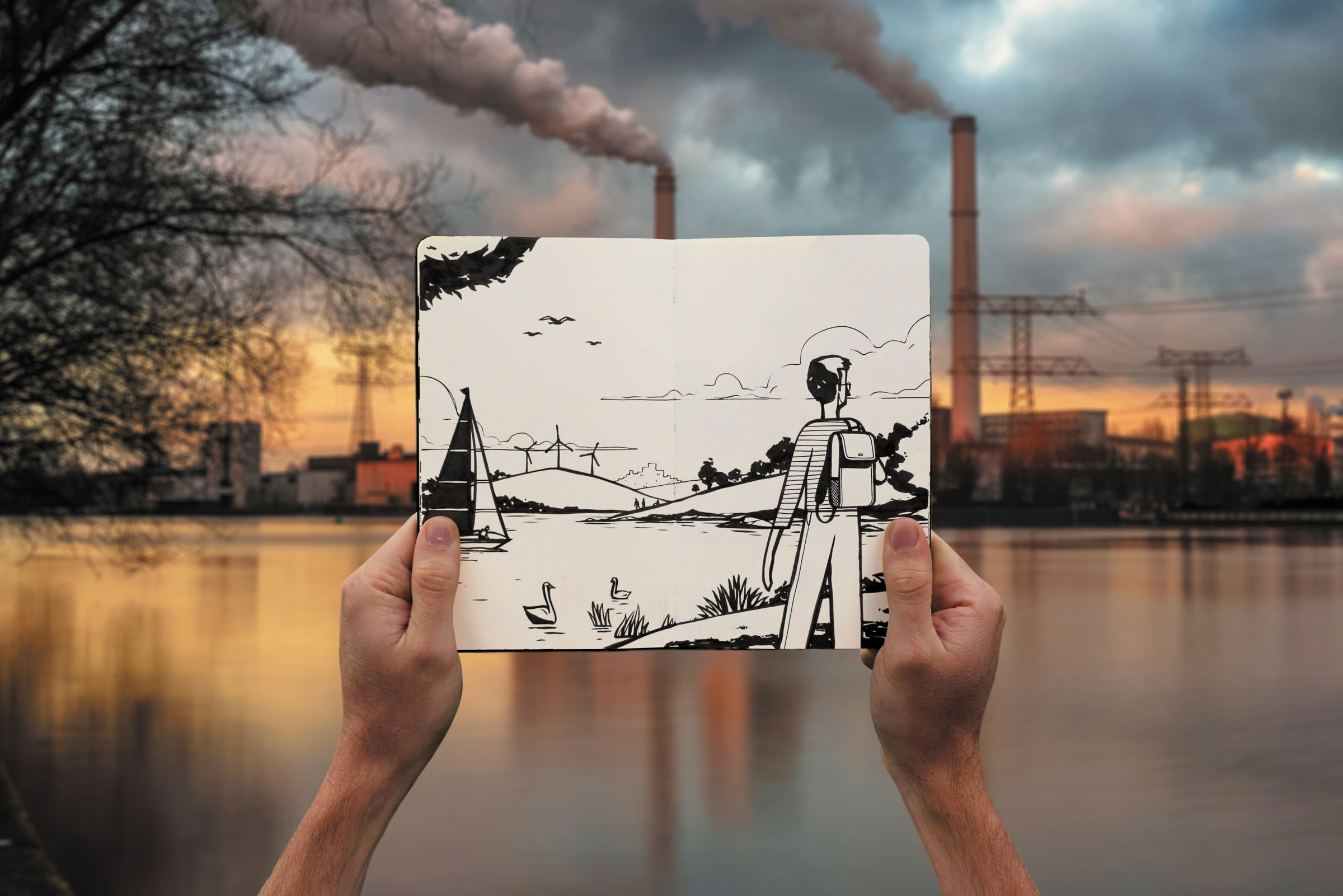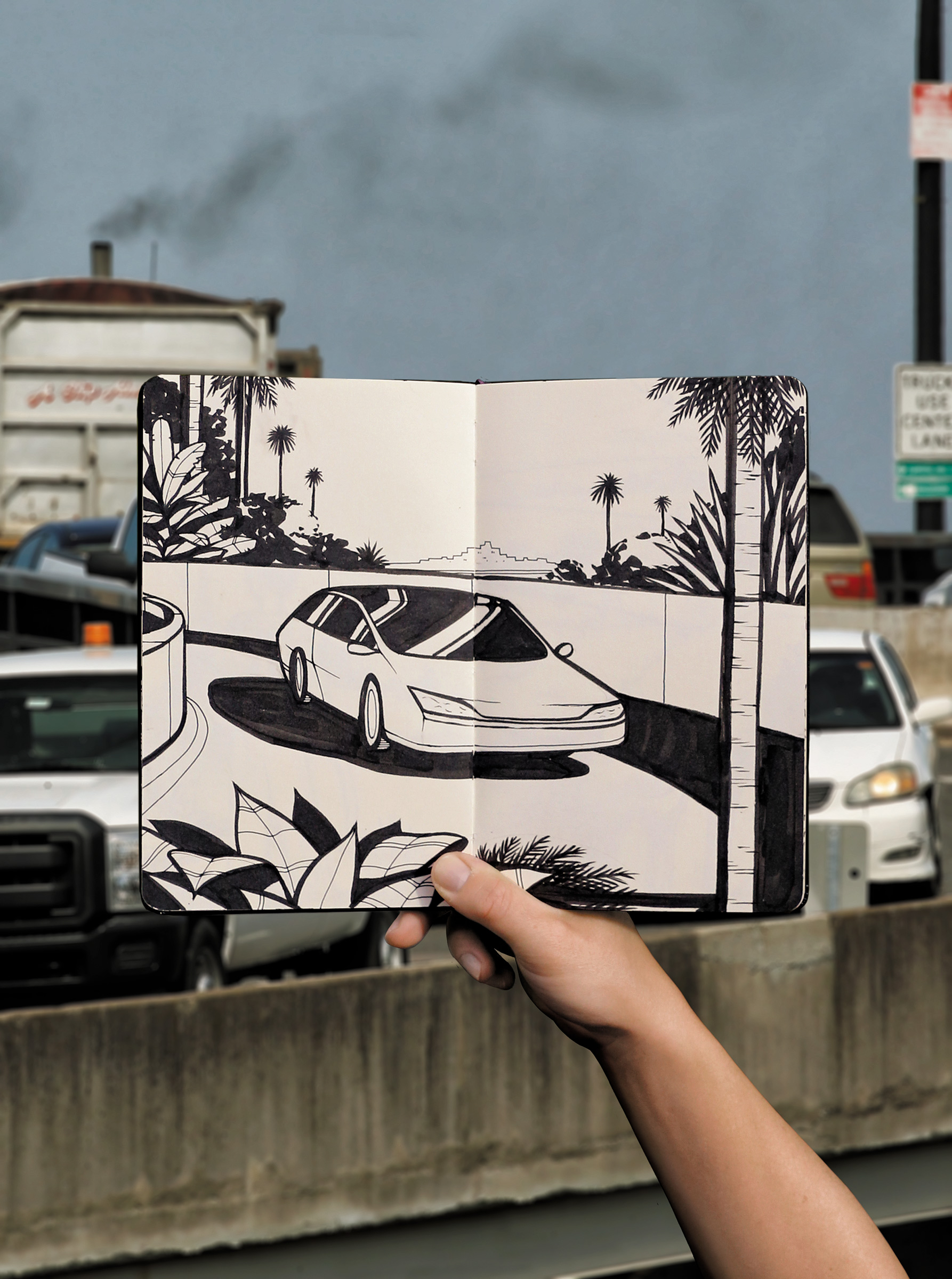
Let’s imagine for a moment that we’ve reached the middle of the century. It’s 2050, and we have a moment to reflect—the climate fight remains the consuming battle of our age, but its most intense phase may be in our rearview mirror. And so we can look back to see how we might have managed to dramatically change our society and economy. We had no other choice.
There was a point after 2020 when we began to collectively realize a few basic things.
One, we weren’t getting out of this unscathed. Climate change, even in its early stages, had begun to hurt: watching a California city literally called Paradise turn into hell inside of two hours made it clear that all Americans were at risk. When you breathe wildfire smoke half the summer in your Silicon Valley fortress, or struggle to find insurance for your Florida beach house, doubt creeps in even for those who imagined they were immune.
Two, there were actually some solutions. By 2020, renewable energy was the cheapest way to generate electricity around the planet—in fact, the cheapest way there ever had been. The engineers had done their job, taking sun and wind from quirky backyard DIY projects to cutting-edge technology. Batteries had plummeted down the same cost curve as renewable energy, so the fact that the sun went down at night no longer mattered quite so much—you could store its rays to use later.
And the third realization? People began to understand that the biggest reason we weren’t making full, fast use of these new technologies was the political power of the fossil-fuel industry. Investigative journalists had exposed its three-decade campaign of denial and disinformation, and attorneys general and plaintiffs’ lawyers were beginning to pick them apart. And just in time.
These trends first intersected powerfully on Election Day in 2020. The Halloween hurricane that crashed into the Gulf didn’t just take hundreds of lives and thousands of homes; it revealed a political seam that had begun to show up in polling data a year or two before. Of all the issues that made suburban Americans—women especially—uneasy about President Trump, his stance on climate change was near the top. What had seemed a modest lead for the Democratic challenger widened during the last week of the campaign as damage reports from Louisiana and Mississippi rolled in; on election night it turned into a rout, and the analysts insisted that an underappreciated “green vote” had played a vital part—after all, actual green parties in Canada, the U.K. and much of continental Europe were also outperforming expectations. Young voters were turning out in record numbers: the Greta Generation, as punsters were calling them, made climate change their No. 1 issue.

And when the new President took the oath of office, she didn’t disappoint. In her Inaugural Address, she pledged to immediately put America back in the Paris Agreement—but then she added, “We know by now that Paris is nowhere near enough. Even if all the countries followed all the promises made in that accord, the temperature would still rise more than 3°C (5°F or 6°F). If we let the planet warm that much, we won’t be able to have civilizations like the ones we’re used to. So we’re going to make the changes we need to make, and we’re going to make them fast.”
Fast, of course, is a word that doesn’t really apply to Capitol Hill or most of the world’s other Congresses, Parliaments and Central Committees. It took constant demonstrations from ever larger groups like Extinction Rebellion, and led by young activists especially from the communities suffering the most, to ensure that politicians feared an angry electorate more than an angry carbon lobby. But America, which historically had poured more carbon into the atmosphere than any other nation, did cease blocking progress. With the filibuster removed, the Senate passed—by the narrowest of margins—one bill after another to end subsidies for coal and gas and oil companies, began to tax the carbon they produced, and acted on the basic principles of the Green New Deal: funding the rapid deployment of solar panels and wind turbines, guaranteeing federal jobs for anyone who wanted that work, and putting an end to drilling and mining on federal lands.
Sign up for One.Five, TIME’s climate change newsletter
Since those public lands trailed only China, the U.S., India and Russia as a source of carbon, that was a big deal. Its biggest impact was on Wall Street, where investors began to treat fossil-fuel stocks with increasing disdain. When BlackRock, the biggest money manager in the world, cleaned its basic passive index fund of coal, oil and gas stocks, the companies were essentially rendered off-limits to normal investors. As protesters began cutting up their Chase bank cards, the biggest lender to the fossil-fuel industry suddenly decided green investments made more sense. Even the staid insurance industry began refusing to underwrite new oil and gas pipelines—and shorn of its easy access to capital, the industry was also shorn of much of its political influence. Every quarter meant fewer voters who mined coal and more who installed solar panels, and that made political change even easier.
As America’s new leaders began trying to mend fences with other nations, climate action proved to be a crucial way to rebuild diplomatic trust. China and India had their own reasons for wanting swift action—mostly, the fact that smog-choked cities and ever deadlier heat waves were undermining the stability of the ruling regimes. When Beijing announced that its Belt and Road Initiative would run on renewable energy, not coal, the energy future of much of Asia changed overnight. When India started mandating electric cars and scooters for urban areas, the future of the internal-combustion engine was largely sealed. Teslas continued to attract upscale Americans, but the real numbers came from lower-priced electric cars pouring out of Asian factories. That was enough to finally convince even Detroit that a seismic shift was under way: when the first generation of Ford E-150 pickups debuted, with ads demonstrating their unmatched torque by showing them towing a million-pound locomotive, only the most unreconstructed motorheads were still insisting on the superiority of gas-powered rides.
Other easy technological gains came in our homes. After a century of keeping a tank of oil or gas in the basement for heating, people quickly discovered the appeal of air-source heat pumps, which turned the heat of the outdoors (even on those rare days when the temperature still dropped below zero) into comfortable indoor air. Gas burners gave way to induction cooktops. The last incandescent bulbs were in museums, and even most of the compact fluorescents had been long since replaced by LEDs. Electricity demand was up—but when people plugged in their electric vehicles at night, the ever growing fleet increasingly acted like a vast battery, smoothing out the curves as the wind dropped or the sun clouded. Some people stopped eating meat, and lots and lots of people ate less of it—a cultural transformation made easier by the fact that Impossible Burgers turned out to be at least as juicy as the pucks that fast-food chains had been slinging for years. The number of cows on the world’s farms started to drop, and with them the source of perhaps a fifth of emissions. More crucially, new diets reduced the pressure to cut down the remaining tropical rain forests to make way for grazing land.
In other words, the low-hanging fruit was quickly plucked, and the pluckers were well paid. Perhaps the fastest-growing business on the planet involved third-party firms that would retrofit a factory or an office with energy-efficient technology and simply take a cut of the savings on the monthly electric bill. Small businesses, and rural communities, began to notice the economic advantages of keeping the money paid for power relatively close to home instead of shipping it off to Houston or Riyadh. The world had wasted so much energy that much of the early work was easy, like losing weight by getting your hair cut.
But the early euphoria came to an end pretty quickly. By the end of the 2020s, it became clear we would have to pay the price of delaying action for decades.
For one thing, the cuts in emissions that scientists prescribed were almost impossibly deep. “If you’d started in 1990 when we first warned you, the job was manageable: you could have cut carbon a percent or two a year,” one eminent physicist explained. “But waiting 30 years turned a bunny slope into a black diamond.” As usual, the easy “solutions” turned out to be no help at all: fracked natural-gas wells were leaking vast quantities of methane into the atmosphere, and “biomass burning”—cutting down forests to burn them for electricity—was putting a pulse of carbon into the air at precisely the wrong moment. (As it happened, the math showed letting trees stand was crucial for pulling carbon from the atmosphere—when secondary forests were allowed to grow, they sucked up a third or more of the excess carbon humanity was producing.) Environmentalists learned they needed to make some compromises, and so most of America’s aging nuclear reactors were left online past their decommissioning dates: that lower-carbon power supplemented the surging renewable industry in the early years, even as researchers continued work to see if fusion power, thorium reactors or some other advanced design could work.
The real problem, though, was that climate change itself kept accelerating, even as the world began trying to turn its energy and agriculture systems around. The giant slug of carbon that the world had put into the atmosphere—more since 1990 than in all of human history before—acted like a time-delayed fuse, and the temperature just kept rising. Worse, it appeared that scientists had systematically underestimated just how much damage each tenth of a degree would actually do, a point underscored in 2032 when a behemoth slice of the West Antarctic ice sheet slid majestically into the southern ocean, and all of a sudden the rise in sea level was being measured in feet, not inches. (Nothing, it turned out, could move Americans to embrace the metric system.) And the heating kept triggering feedback loops that in turn accelerated the heating: ever larger wildfires, for instance, kept pushing ever more carbon into the air, and their smoke blackened ice sheets that in turn melted even faster.
This hotter world produced an ongoing spate of emergencies: “forest-fire season” was now essentially year-round, and the warmer ocean kept hurricanes and typhoons boiling months past the old norms. And sometimes the damage was novel: ancient carcasses kept emerging from the melting permafrost of the north, and with them germs from illnesses long thought extinct. But the greatest crises were the slower, more inexorable ones: the ongoing drought and desertification was forcing huge numbers of Africans, Asians and Central Americans to move; in many places, the heat waves had literally become unbearable, with nighttime temperatures staying above 100°F and outdoor work all but impossible for weeks and months at a time. On low-lying ground like the Mekong Delta, the rising ocean salted fields essential to supplying the world with rice. The U.N. had long ago estimated the century could see a billion climate refugees, and it was beginning to appear it was unnervingly correct. What could the rich countries say? These were people who hadn’t caused the crisis now devouring their lives, and there weren’t enough walls and cages to keep them at bay, so the migrations kept roiling the politics of the planet.

There were, in fact, two possible ways forward. The most obvious path was a constant competition between nations and individuals to see who could thrive in this new climate regime, with luckier places turning themselves into fortresses above the flood. Indeed some people in some places tried to cling to old notions: plug in some solar panels and they could somehow return to a more naive world, where economic expansion was still the goal of every government.
But there was a second response that carried the day in most countries, as growing numbers of people came to understand that the ground beneath our feet had truly shifted. If the economy was the lens through which we’d viewed the world for a century, now survival was the only sensible basis on which to make decisions. Those decisions targeted not just carbon dioxide; these societies went after the wild inequality that also marked the age. The Green New Deal turned out to be everything the Koch brothers had most feared when it was introduced: a tool to make America a fairer, healthier, better-educated place. It was emulated around the world, just as America’s Clean Air Act had long served as a template for laws across the globe. Slowly both the Keeling Curve, measuring carbon in the atmosphere, and the Gini coefficient, measuring the distribution of wealth, began to flatten.
That’s where we are today. We clearly did not “escape” climate change or “solve” global warming—the temperature keeps climbing, though the rate of increase has lessened. It’s turned into a wretched century, which is considerably better than a catastrophic one. We ended up with the most profound and most dangerous physical changes in human history. Our civilization surely teetered—and an enormous number of people paid an unfair and overwhelming price—but it did not fall.
People have learned to defend what can be practically defended: expensive seawalls and pumps mean New York is still New York, though the Antarctic may yet have something to say on the subject. Other places we’ve learned to let go: much of the East Coast has moved in a few miles, to more defensible ground. Yes, that took trillions of dollars in real estate off the board—but the roads and the bridges would have cost trillions to defend, and even then the odds were bad.
Cities look different now—much more densely populated, as NIMBY defenses against new development gave way to an increasingly vibrant urbanism. Smart municipalities banned private cars from the center of town, opening up free public-transit systems and building civic fleets of self-driving cars that got rid of the space wasted on parking spots. But rural districts have changed too: the erratic weather put a premium on hands-on agricultural skills, which in turn provided opportunities for migrants arriving from ruined farmlands elsewhere. (Farming around solar panels has become a particular specialty.) America’s rail network is not quite as good as it was in the early 20th century, but it gets closer each year, which is good news since low-carbon air travel proved hard to get off the ground.
What’s changed most of all is the mood. The defiant notion that we would forever overcome nature has given way to pride of a different kind: increasingly we celebrate our ability to bend without breaking, to adapt as gracefully as possible to a natural world whose temper we’ve come to respect. When we look back to the start of the century we are, of course, angry that people did so little to slow the great heating: if we’d acknowledged climate change in earnest a decade or two earlier, we might have shaved a degree off the temperature, and a degree is measured in great pain and peril. But we also know it was hard for people to grasp what was happening: human history stretched back 10,000 years, and those millennia were physically stable, so it made emotional sense to assume that stability would stretch forward as well as past.
We know much better now: we know that we’ve knocked the planet off its foundations, and that our job, for the foreseeable centuries, is to absorb the bounces as she rolls. We’re dancing as nimbly as we can, and so far we haven’t crashed.
This is one article in a series on the state of the planet’s response to climate change. Read the rest of the stories and sign up for One.Five, TIME’s climate change newsletter.
More Must-Reads From TIME
- The 100 Most Influential People of 2024
- Coco Gauff Is Playing for Herself Now
- Scenes From Pro-Palestinian Encampments Across U.S. Universities
- 6 Compliments That Land Every Time
- If You're Dating Right Now , You're Brave: Column
- The AI That Could Heal a Divided Internet
- Fallout Is a Brilliant Model for the Future of Video Game Adaptations
- Want Weekly Recs on What to Watch, Read, and More? Sign Up for Worth Your Time
Contact us at letters@time.com
